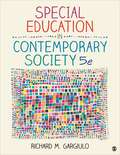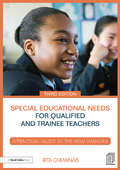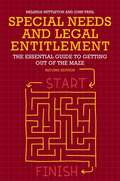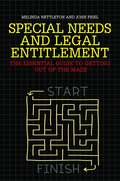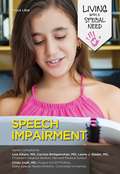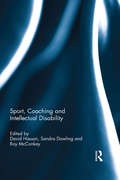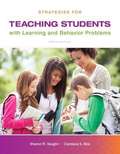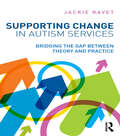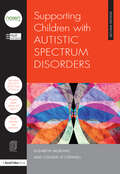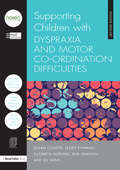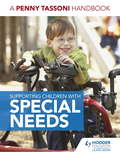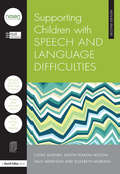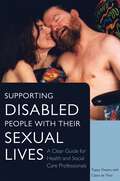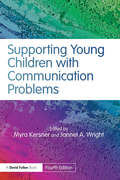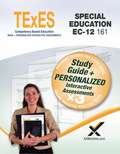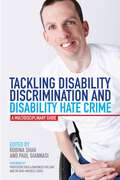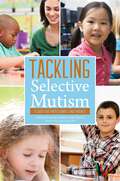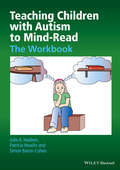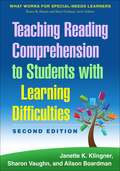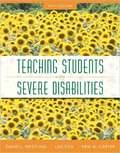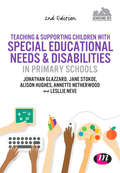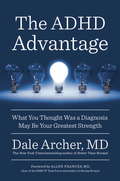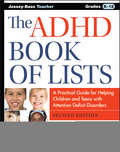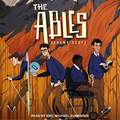- Table View
- List View
Special Education in Contemporary Society: An Introduction to Exceptionality (Fifth Edition)
by Richard M. GargiuloThe Fifth Edition of Richard Gargiulo's well-respected Special Education in Contemporary Society: An Introduction to Exceptionality offers a comprehensive, engaging, and easy-to-read introduction to special education. Grounded in research and updated to reflect the most current thinking and standards of the field, the book provides students with the skills and knowledge to become successful teachers. Gargiulo's text encourages a deep awareness and understanding of the human side of special education. The book provides students a rare glimpse into the lives of exceptional students and their families, as well as the teachers that work with exceptional persons throughout their lives.
Special Educational Needs for Qualified and Trainee Teachers: A practical guide to the new changes
by Rita CheminaisThis completely revised and updated edition, previously published as Special Educational Needs for NQTs and TAs, addresses the latest Teachers’ Standards, and their application in meeting the most recent developments and changes in the special educational needs system and the new SEN Code of Practice. Essential reading and an invaluable guide for all qualified, newly qualified and trainee teachers, this highly practical text relates to those accessing SEN training via teaching school alliances, as well as Higher Education. Full of tips and strategies on how to meet the needs of a diversity of children and young people with special educational needs, in a range of educational settings, chapters cover: the latest Teachers’ Standards aligned to the most recent SEND changes the revised SEN Code of Practice, the Children and Families Act, and the Equality Act and its related Duties teaching schools, specialist leaders of education in SEN, and new training models for building teacher capacity in SEN how to meet the latest OFSTED inspection requirements for SEND what works best in the effective teaching of pupils with SEN and those eligible for the pupil premium Featuring useful checklists, templates and photocopiable, downloadable resources to support professional development in SEN, this practical resource contains a wealth of valuable advice, in addition to signposting to further information. This no-nonsense, down-to-earth authoritative text will provide essential reading for all experienced qualified, newly qualified and trainee teachers, as well as to those delivering SEND training in Higher Education, local authorities, and in teaching schools and their alliances.
Special Needs and Legal Entitlement, Second Edition: The Essential Guide to Getting out of the Maze
by Melinda Nettleton John FrielFully updated to include the most recent developments in law and practice, the second edition of this comprehensive and straightforward guide to the legal rights of children and young people with special educational needs clearly explains the key issues in a complex system. Helping parents to understand the legal entitlements of their child, Nettleton and Friel explain the new Education, Health and Care Plans which have replaced the Statements of Special Educational Needs. They explain what an Education, Health and Care Plan is, how assessments are carried out, and how annual reviews, amendments, rights of appeal and tribunals work in practice. They also include help with 42 of the most common problems encountered, a discussion of relevant cases, extracts from the official published guidance issued, and a draft Reasons for Appeal. This essential handbook for parents of children with special educational needs will also be a key reference for teachers, charities, Local Authority officers, and lawyers in other fields.
Special Needs and Legal Entitlement: The Essential Guide to Getting out of the Maze
by Melinda Nettleton John Friel Columb FrielThis straightforward, comprehensive guide to the legal rights of children and young people with special educational needs includes all the most recent developments in law, and clearly explains the key issues in a complex system. Helping parents to understand the legal entitlements of their child, Nettleton and Friel explain the new Education, Health and Care Plans which have replaced the Statements of Special Educational Needs. They explain what an Education, Health and Care Plan is, how assessments are carried out, and how annual reviews, amendments, rights of appeal and tribunals work in practice. They also include help with 25 of the most common problems encountered, a discussion of relevant cases, extracts from the official published guidance issued, and a draft Reasons for Appeal. This essential handbook for parents of children with special educational needs will also be a key reference for teachers, charities, Local Authority officers, and lawyers in other fields.
Speech Impairment
by Joyce LibalWhen a young person can't speak easily, sometimes other kids think he's not very intelligent. That's often not the case, though. A person with a speech impairment may be just as bright as anyone else. In this book, you'll read about David, who struggles with stuttering, and Martha, who has difficulty articulating certain sounds. You'll discover how they overcome their challenges--and how they rise above the prejudice they each face.
Sport, Coaching and Intellectual Disability
by David Hassan Sandra Dowling Roy McConkeyThere are more opportunities than ever before for young people with disabilities to participate in sport and adapted physical education. For example, there are more than 3.7 million athletes worldwide aligned to the Special Olympics organisation, with national associations active in more than 200 countries worldwide. Despite this rapid growth, all too often coaches and teachers lack adequate knowledge of the particular challenges faced by people with intellectual disabilities. The principal aim of this book is to improve the understanding and professional skills of coaches, teachers, practitioners and researchers, to promote awareness of successful programmes addressing the needs of such young people, and to challenge the prevailing myths and stereotypes surrounding their abilities. With contributions from leading researchers and practitioners around the world, this book is the first to explore in depth the topic of sport and intellectual disability from a coaching perspective. Including both theoretical discussion and empirical case-studies, the book covers a full range of contemporary issues and themes, including training and coaching, family support, perceptions of disability, athlete motivation, positive sport experiences, motor development programmes, and social and cultural aspects of disability. Sport Coaching and Intellectual Disability is important reading for any student, researcher, coach, teacher, manager or policy maker with an interest in disability sport, physical education, coaching, or mainstream disability studies.
Strategies for Teaching Students with Learning and Behavior Problems,Ninth Edition
by Sharon Vaughn Candace S. BosFor courses in Mid/Moderate Disabilities Methods (Special Education); Methods for Students with Learning and Behavior Problems (Special Education) This bestselling text focuses on presenting the ideal content for preparing teachers to meet the needs of elementary and secondary students with learning and behavior problems in a variety of settings. Streamlined in the previous edition to provide more hands on applications and classroom strategies than any other methods text on the market, this new Ninth Edition presents fresh ideas and information on best practices through the use of embedded video clips, web links, and step-by-step instructional strategies. Featured in this edition are a new emphasis on and integration of the Common Core State Standards (CCSS) throughout; updated coverage of RtI; a new emphasis on higher level thinking, including reading comprehension and complex texts as well as problem solving, fractions, and algebra; increased focus on classroom management and positive behavior support; and updated and enhanced key research, practice opportunities, and strategies throughout.
Supporting Change in Autism Services: Bridging the gap between theory and practice
by Jackie RavetSupporting Change in Autism Services explores the theoretical and practical dimensions of improving service provision for children, young people and adults with autism. The core aim of the book is to identify and critically examine some of the key factors that either facilitate or inhibit the implementation of good autism practice at both practitioner level and workplace level. It shows practitioners and students how to successfully translate autism theory into practice across service contexts and showcases a range of practitioner case studies throughout the text in order to illustrate effective implementation.? Topics explored include: controversies and ambiguities in autism policy, theory and discourse; understanding autism in an inclusive context; enabling participation; making sense of behaviour; autism and interprofessionalism; strategic planning for autism friendly services; bridging the implementation gap. This book is essential reading for anyone interested in improving services for people with autism in the education, social care, health and voluntary sectors.
Supporting Children with Autistic Spectrum Disorders (21st Century Business Management)
by Hull City CouncilThis practical resource contains a wealth of valuable advice and tried-and-tested strategies for identifying children and young people with Autistic Spectrum Disorders (ASD). This fully updated text describes the different types of difficulties experienced by pupils with ASD and helps practitioners to understand their diverse needs. This fully updated new edition explores key topics, including: organizing the classroom and support staff home-school liaison and working with siblings transition to adulthood independence skills whole school implications. Now fully updated in line with the SEND 2014 Code of Practice, this invaluable guide provides guidance and practical strategies for teachers and other professionals, helping them to feel more confident, and be more effective in supporting learners in a variety of settings. For professional development, this book also provides materials for in-house training sessions, and features useful checklists, templates and photocopiable/downloadable resources.
Supporting Children with Dyspraxia and Motor Co-ordination Difficulties (nasen spotlight)
by Hull City Council Susan Coulter Lesley Kynman Elizabeth MorlingCompletely revised and updated in light of the new SEND 2014 Code of Practice, this new edition supports teachers in making good provision for children and young people with a range of co-ordination difficulties. Offering practical tips and strategies on how to meet the needs of children and young people with dyspraxia and other coordination difficulties in a range of educational settings, this book features timesaving checklists, templates and photocopiable resources to support professional development. The wide-ranging and accessible chapters explore topics including: Identification of different types of motor co-ordination difficulties Implications for classroom practice Understanding core skill development Assessment practices Written by practitioners, for practitioners, it also contains a wealth of tried and tested strategies and provides clear best-practice guidance for developing outstanding provision in inclusive settings. Susan Coulter – Senior Support Teacher for the Education Service for Disability at Hull City Council, UKLesley Kynman - Senior Support Teacher for the Education Service for Disability at Hull City Council. UKElizabeth Morling - SEN consultant and series editorRob Grayson – Team Leader, Integrated Physical and Sensory Services at Hull City Council, UKJill Wing – Senior Support Teacher, Integrated Physical and Sensory Services at Hull City Council, UK
Supporting Children with Special Needs: A Penny Tassoni Handbook
by Penny TassoniSupport the individual needs of children with this practical and informative guide from Penny TassoniFully matched to the new 2014 Special Education Needs and Disability Code of Practice, this Penny Tassoni Handbook explores supporting children with individual needs, working with parents and the issues surrounding SEN and disability. Tassoni's signature style and approach ensures that the government code is translated into a practical, informative and easy-to-read guide for anyone working in the role of a SENCO.- Helps you tailor your strategies in the key areas of communication & interaction, cognition & learning, social, emotional & mental health and sensory and/or physical needs.- Includes a detailed reference section on a wide range of specific needs from autism spectrum condition through to Fragile X.- Uses colourful design and illustrative photos which make theory easy to understand and to put into practice in real world scenarios.- Written in Penny Tassoni's easy-to-read, informative and practical style.
Supporting Children with Speech and Language Difficulties (nasen spotlight)
by Hull City CouncilCompletely revised and updated in light of the new SEND 2014 Code of Practice, this new edition describes the different types of difficulties experienced by pupils with speech, language and communication needs. It will help teachers and other professionals to feel more confident by providing expert guidance and practical strategies, and as a professional development tool, will also encourage outstanding practice by suggesting ideas and materials for in-house training sessions. The wide-ranging and accessible chapters explore topics including: Listening skills Phonological awareness Comprehension of language Activities for circle time Working with parents Featuring useful checklists, templates and photocopiable resources, this practical resource contains a wealth of valuable advice and tried-and-tested strategies for identifying children and young people with speech, language and communication needs, ensuring they have the support they need to make exceptional progress.
Supporting Disabled People with their Sexual Lives: A Clear Guide for Health and Social Care Professionals
by Tuppy OwensMany health and social care professionals today feel untrained, fearful and ill-equipped to support their disabled patients, clients and service users in their sexual lives. The result is that disabled people can be left feeling frustrated and afraid that their sexual needs will be forever unrecognised and unmet. This is a straight-talking guide to supporting disabled people with their sexual lives. It covers the range of difficulties disabled people experience, from physical limitations to problems such as lack of acceptance, knowledge and skills. The real difficulties professionals experience are also covered with positive suggestions, and a chapter on communication discusses how to discuss sex. Sections follow on the sexual services available to help, and the wide range of sexual diversities which disabled people can and do enjoy. A chapter by Claire de Than covers the law. This clear, down-to-earth guide will be essential reading for all those working with or supporting disabled people, from care home workers and managers to social workers, medical staff and therapists.
Supporting Young Children with Communication Problems
by Myra Kersner Jannet A. WrightNow in its fourth edition, formerly published as How to Manage Communication Problems in Young Children, this invaluable guide to understanding and helping children whose speech and/or language is delayed or impaired has been completely revised and updated, and provides readers with: Practical advice on how to recognise communication problems Strategies for supporting children with speech, language and communication needs Best practice guide for parents and professionals working in partnership Contributions from a wide-range of specialist speech and language therapists Reflecting new developments and current practice, this book is of interest to parents, early years’ practitioners, students in education and speech and language therapy, and anyone interested in pursuing a career with young children in the foundation years. Written in an accessible style, it assumes no prior knowledge and includes a range of practical suggestions for dealing with children with all kinds of communication difficulties.
TExES Special Education EC-12 161: Teacher Certification
by Sharon A. WynneAre you ready to become a special education teacher in Texas? Use XAMonline’s TExES Special Education EC-12 study guide to help you pass your teacher certification exam and advance your career. <p><p> Aligned with current TExES standards, our study guide provides a comprehensive review of all nine domains, including:<p> Legal Mandates and Historical Aspects<br> Identification Characteristics<br> Processing Skills<br> Assessment Methods, Use, and interpretation<br> Classroom Management<br> Teaching Strategies<br> Curriculum and Instructional Content<br> Instructional Materials and Technology, and<br> Support and Professionals<br> <p> We give you a thorough review of all domains, competencies, skills, and focus statements tested on the TExES Special Education EC-12 (161) exam. Unlike other teacher certification test preparation material, our TExES Special Education EC-12 study guide drills all the way down to the focus statement level, providing detailed examples of the range, type, and level of content that appear on the test. <p> The book includes three full-length multiple-choice practice tests to help you test your knowledge, understand how the exam is weighted, and identify skills and competencies you need to focus on. Our detailed answer explanations reference related skills in the book, allowing you to identify your strengths and weaknesses and interact with the content effectively. Maximize your study by prioritizing domains and skills you need to focus on the most to pass the exam. <p> This study guide is perfect for college students, teachers, and career-changing professionals who want to become a special education teacher in Texas.
Tackling Disability Discrimination and Disability Hate Crime: A Multidisciplinary Guide
by David Cain Mike Smith Sheila Hollins Melanie Giannasi Robina Shah Kathryn Stone Catherine White Mark Brookes Paul Frederick Matt Houghton Paul Giannasi Bob Munn Nathan Hall Phillipa Russell Lord Nigel Crisp Jemma Tyson Sylvia Lancaster Syed Mohammed NaqviPlacing the experiences of victims at its heart, this book provides an authoritative overview of disability hate crime - explaining what it is, how it happens, its legal status, the impact on victims and how individuals and agencies should respond. The guide outlines innovative projects developed to address the problem, and provides tailored guidance for professionals spanning education, health and social care, and criminal justice. It also offers recommendations for effective multi-agency working. After highlighting the crimes committed against disabled people and society's failure to protect them, the book concludes with a powerful argument for cross-government action to improve professional practice and eliminate disability-motivated hate crime.
Tackling Selective Mutism: A Guide for Professionals and Parents
by Tony Cline Alison Wintgens Maggie Johnson Jenny Packer Nitza Katz-Bernstein Geoffrey Gibson David Bramble Johnston Susan Lindsay Whittington Victoria Roe Denise Lanes Charlotte Firth Kate Jones Keiko Kakuta Alice Sluckin Jane Kay Rosemary Sage Benita Rae Smith Miriam Jemmett Jyoti Sharma Carl Sutton Hilary M Cleator Jean GrossBringing together the latest research and understanding on selective mutism, this edited book gives essential information on the various treatment and therapy options. Experts in the fields of speech and language therapy, psychology, music therapy education and communication offer a wide range of professional perspectives on the condition, while case studies from people with selective mutism, past sufferers and parents reveal the personal impact. The book also clarifies what support a person with selective mutism is likely to need at home, school and in social situations. This definitive volume on selective mutism will be key reading for professionals such as speech and language therapists, educational psychologists, child psychiatrists, child and adolescent mental health workers and anyone working with selective mutism in therapeutic and educational settings, as well as family members wanting a closer understanding of what selective mutism is and how they can help.
Teaching Children with Autism to Mind-Read
by Simon Baron-Cohen Julie A. Hadwin Patricia HowlinThis workbook expands upon the authors? Teaching Children with Autism to Mind-Read: A Practical Guide to present the most effective approaches, strategies, and practical guidelines to help alleviate social and communication problems in individuals with Autism Spectrum Disorders (ASD).Complements the best-selling Teaching Children with Autism to Mind-Read: A Practical Guide for use in practical settingsAnswers the need for more training of professionals in early interventions for children assessed with ASD called for by the National Plan for AutismWritten by a team of experts in the fieldCovers issues such as how to interpret facial expressions; how to recognize feelings of anger, sadness, fear and happiness; how to perceive how feelings are affected by what happens and what is expected to happen; how to see things from another person?s perspective; and how to understand another person?s knowledge and beliefs
Teaching Reading Comprehension to Students with Learning Difficulties, 2/E
by Sharon Vaughn Janette K. Klingner Alison BoardmanThis practitioner resource and course text has given thousands of K-12 teachers evidence-based tools for helping students--particularly those at risk for reading difficulties--understand and acquire new knowledge from text. The authors present a range of scientifically validated instructional techniques and activities, complete with helpful classroom examples and sample lessons. The book describes ways to assess comprehension, build the skills that good readers rely on, and teach students to use multiple comprehension strategies flexibly and effectively. Each chapter features thought-provoking discussion questions. Reproducible lesson plans and graphic organizers can be downloaded and printed in a convenient 8 1/2" x 11" size. New to This Edition *Chapters on content-area literacy, English language learners, and intensive interventions. *Incorporates current research on each component of reading comprehension. *Discusses ways to align instruction with the Common Core State Standards. *Additional instructional activities throughout.
Teaching Students with Severe Disabilities
by Erik Carter David Westling Lise FoxProvides comprehensive coverage of the major issues pertinent to teaching students with severe disabilities―highly useful information presented in way readers can readily understand and apply. KEY TOPICS: Students with severe disabilities: definitions, descriptions, characteristics, and potential; philosophies and practices for teaching students with severe disabilities; collaboration among professionals and paraprofessionals; parents, families, and cultural issues; planning instructional programs for students with severe disabilities; determining instructional goals for students with severe disabilities; teaching students to acquire new skills; teaching skills for generalization and maintenance; evaluating student progress; creating inclusive educational environments; teaching communication skills; providing behavior support to improve challenging behavior; managing sensory and motor systems; providing support for health and medical needs; teaching personal care skills; fostering friendships and recreational involvement; teaching academic skills; teaching community and domestic skills; using assistive technology; meeting the needs of young children; transitioning to adulthood. MARKET: For educators involved in teaching students with severe learning disabilities or moderate and severe.
Teaching and Supporting Children with Special Educational Needs and Disabilities in Primary Schools (Achieving QTS Series)
by Jonathan Glazzard Alison Hughes Annette Netherwood Lesley Neve Jane StokoeIf you are a primary trainee, or are training to support children in primary schools, this is your guide to working with children with Special Educational Needs and Disabilities (SEND). We begin by exploring what is meant by SEND in primary schools and go on to cover all you need to know about your statutory responsibilities in school. Current legislation and the Code of Conduct are covered, to give you lots of information about the content you will be working in. The book then examines the range of needs you will encounter in primary schools giving you details information and practical advice. This second edition has been fully restructured and updated to include a new section on the key theory relating to SEND. Exploring theories and theorist that you will need to know about to fully understand how to support children. Also new for this edition is a chapter focusing on the role of the SENCO in the primary school. Finally, the book includes more practical support to help you in the classroom. Checklists to help you to work comprehensively and information about useful resources and outside agencies.
Teaching and Supporting Children with Special Educational Needs and Disabilities in Primary Schools (Achieving QTS Series)
by Jonathan Glazzard Alison Hughes Annette Netherwood Lesley Neve Jane StokoeIf you are a primary trainee, or are training to support children in primary schools, this is your guide to working with children with Special Educational Needs and Disabilities (SEND). We begin by exploring what is meant by SEND in primary schools and go on to cover all you need to know about your statutory responsibilities in school. Current legislation and the Code of Conduct are covered, to give you lots of information about the content you will be working in. The book then examines the range of needs you will encounter in primary schools giving you details information and practical advice. This second edition has been fully restructured and updated to include a new section on the key theory relating to SEND. Exploring theories and theorist that you will need to know about to fully understand how to support children. Also new for this edition is a chapter focusing on the role of the SENCO in the primary school. Finally, the book includes more practical support to help you in the classroom. Checklists to help you to work comprehensively and information about useful resources and outside agencies.
The ADHD Advantage
by Dale ArcherWhy ADHD could be the key to your successFor decades physicians delivered the diagnosis of ADHD to patients as bad news and warned them about a lifelong struggle of managing symptoms. But The ADHD Advantage explodes this outlook, showing that some of the most highly successful entrepreneurs, leaders, and entertainers have reached the pinnacle of success not in spite of their ADHD but because of it.Although the ADHD stereotype is someone who can't sit still, in reality people with ADHD are endlessly curious, often adventurous, willing to take smart risks, and unusually resilient. They are creative, visionary, and entrepreneurial. Sharing the stories of highly successful people with ADHD, Dr. Archer offers a vitally important and inspiring new way to recognize ADHD traits in oneself or in one's loved ones, and then leverage them to great advantage--without drugs.As someone who not only has ADHD himself but also has never used medication to treat it, Dr. Archer understands the condition from a unique standpoint. Armed with new science and research, he hopes to generate public interest and even debate with his positive message as he guides the millions of people with ADHD worldwide toward a whole new appreciation of their many strengths and full innate potential.
The ADHD Book of Lists
by Sandra F. RiefPractical ADHD management techniques for parents and teachers The ADHD Book of Lists is a comprehensive guide to ADHD/ADD, providing the answers parents, teachers, and other caregivers seek in a convenient list format. This new second edition has been updated with the latest research findings and resources, including the most up to date tools and strategies for helping these children succeed. Each aspect of ADHD/ADD is fully explained, from diagnosis to intervention, providing readers with the insight they need to make the best choices for the affected child. Coverage includes the latest medications and behavioral management techniques that work inside and outside the classroom, plus guidance toward alleviating individual struggles including inattention, impulsivity, executive function and subject-specific academic issues. Readers learn how to create a collaborative care team by bringing parents, teachers, doctors, therapists, and counselors on board to build a comprehensive management plan, as well as the practical techniques they can use every day to provide these children the support they need to be their very best. Attention Deficit/Hyperactivity Disorder cannot be cured, but it can be managed. Children with ADHD/ADD do not outgrow it, but the adults in their lives play a major role in what these children achieve and how they feel about themselves. This book is an insightful guide to supporting children with ADHD, and giving them the mental, emotional, and practical tools that boost their confidence and abilities. Investigate comprehensive treatments, including ADHD coaching Learn strategies for strengthening organization, working memory and other executive functions. Understand effective classroom management of students with ADHD Discover ways to help struggling children succeed despite the challenges There is a high correlation between ADHD and a number of negative outcomes when not treated, but the tide is turning as more effective management becomes commonplace. The ADHD Book of Lists is the complete easy-to-reference guide to practical ADHD management.
The Ables
by Jeremy ScottI did have fantastic hearing, mostly by virtue of being blind. But that couldn't actually mean that he's trying to tell me I have super powers, right? Because that would be ridiculous. <p><p> It wasn't the "sex talk" he expected. Phillip Sallinger's dad has told him he's a custodian - a guardian - and his genetically inherited power is telekinesis. He'll learn to move objects with his mind. He's excited to begin superhero high school until he discovers he's assigned to a "special ed" class for disabled empowered kids; he suddenly feels like an outsider. Bullied, threatened, and betrayed, Phillip struggles, even as he and his friends - calling themselves the Ables - find ways to maximize their powers to overcome their disabilities, and are the first to identify the growing evil threatening humanity. As vital custodians disappear and the custodian leadership is mired in indecision, a mysterious and powerful figure taunts Phillip, and the enemy is poised to strike. But what if the next "one who does all," the multi-gifted custodian predicted to come, is one of the Ables? <p><p> The Ables is a fast-paced, captivating debut novel from Jeremy Scott, a bold, new voice in fantasy and science fiction.
